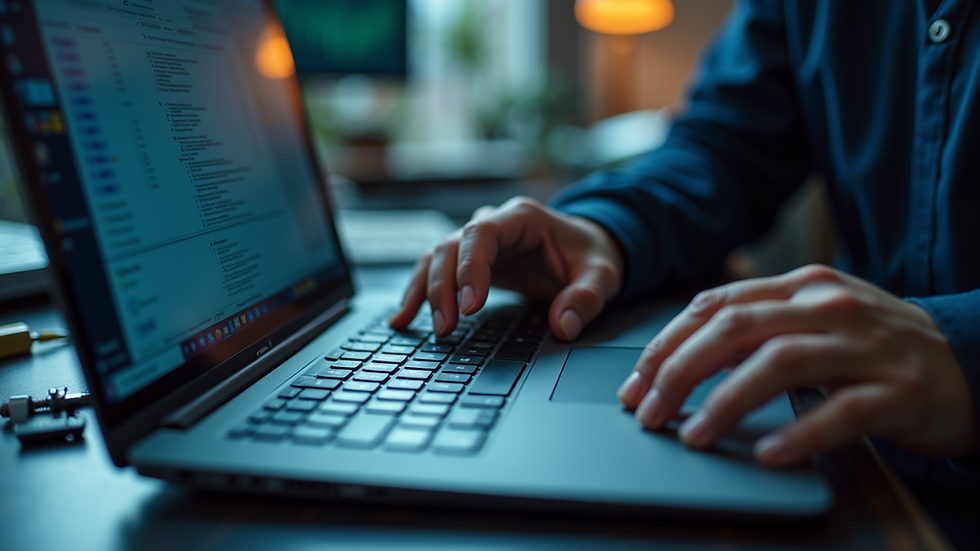Top Tips for Laptop Repairs at Computer Club
- rhiannalandells
- Aug 12
- 4 min read
Laptops are essential tools in our daily lives. Whether for work, school, or leisure, a malfunctioning laptop can be a major inconvenience. At Computer Club, we understand how frustrating it can be when your laptop stops working. That’s why we’ve compiled some top tips for laptop repairs to help you troubleshoot common issues and get your device back in working order.
Understanding Common Laptop Issues
Before diving into repairs, it’s important to recognize the common problems that laptops face. Here are a few frequent issues:
Battery Problems: A laptop that won’t charge or holds a charge for only a short time can be a sign of battery failure.
Overheating: If your laptop feels hot to the touch or shuts down unexpectedly, it may be overheating.
Slow Performance: A laptop that takes forever to boot up or run applications may have software issues or insufficient memory.
Screen Issues: Flickering screens or blank displays can indicate hardware problems.
By identifying these issues early, you can take steps to address them before they worsen.
Basic Troubleshooting Steps
When your laptop starts acting up, the first step is to troubleshoot. Here are some basic steps you can take:
Restart Your Laptop: This simple action can resolve many minor issues.
Check Connections: Ensure that all cables and connections are secure. This includes power cords and peripherals.
Run a Virus Scan: Malware can slow down your laptop. Use your antivirus software to scan for and remove any threats.
Free Up Space: If your hard drive is nearly full, it can affect performance. Delete unnecessary files or move them to an external drive.
Update Software: Keeping your operating system and applications up to date can fix bugs and improve performance.
By following these steps, you may be able to resolve the issue without needing professional help.
When to Seek Professional Help
Sometimes, the problem is beyond basic troubleshooting. Here are signs that it’s time to seek professional help:
Physical Damage: If your laptop has been dropped or exposed to liquid, it’s best to consult a professional.
Persistent Issues: If you’ve tried troubleshooting but the problem persists, don’t hesitate to reach out for help.
Unusual Noises: Grinding or clicking sounds can indicate hardware failure, which requires immediate attention.
Error Messages: Frequent error messages can signal deeper issues that need expert diagnosis.
Recognizing these signs can save you time and prevent further damage to your laptop.
DIY Repairs: What You Can Fix
If you’re feeling adventurous, there are some repairs you can attempt on your own. Here are a few DIY repairs that are generally safe for beginners:
Replacing the Battery
If your laptop battery is no longer holding a charge, replacing it can be a straightforward process. Here’s how:
Power Down: Turn off your laptop and unplug it.
Remove the Battery: Depending on your model, you may need to slide a latch or unscrew the battery compartment.
Insert the New Battery: Place the new battery in the compartment and secure it.
Power Up: Plug in your laptop and turn it on to check if the new battery works.
Upgrading RAM
If your laptop is slow, upgrading the RAM can improve performance. Here’s a simple guide:
Check Compatibility: Ensure the new RAM is compatible with your laptop model.
Open the Laptop: Power down and unplug your laptop. Remove the back panel to access the RAM slots.
Install the New RAM: Carefully insert the new RAM into the slot at an angle and press down until it clicks into place.
Reassemble and Test: Replace the back panel, power on your laptop, and check if the performance has improved.
Cleaning the Fans
Overheating can often be resolved by cleaning the laptop’s fans. Here’s how:
Power Down: Turn off your laptop and unplug it.
Open the Laptop: Remove the back panel to access the fans.
Use Compressed Air: Blow compressed air into the fans to remove dust and debris.
Reassemble: Replace the back panel and power on your laptop.
These DIY repairs can save you money and give you a sense of accomplishment.
Preventive Maintenance Tips
Prevention is always better than cure. Here are some tips to keep your laptop in good shape:
Regular Updates: Keep your operating system and software updated to avoid bugs and security issues.
Use a Cooling Pad: If you use your laptop for extended periods, a cooling pad can help prevent overheating.
Clean Your Laptop: Regularly clean your laptop’s keyboard and screen to prevent dust buildup.
Backup Your Data: Always back up important files to avoid data loss in case of hardware failure.
By following these preventive measures, you can extend the life of your laptop and reduce the need for repairs.
Choosing the Right Repair Service
If you decide to seek professional help, choosing the right repair service is crucial. Here are some tips to find a reliable service:
Check Reviews: Look for customer reviews online to gauge the quality of service.
Ask for Recommendations: Friends and family can provide valuable insights into trustworthy repair services.
Inquire About Warranties: A good repair service should offer warranties on their work and parts.
Get a Quote: Before committing, ask for a detailed quote to avoid unexpected costs.
Taking the time to choose the right service can save you money and ensure your laptop is in good hands.
Final Thoughts
Laptop repairs can be daunting, but with the right knowledge and tools, you can tackle many issues yourself. Remember to troubleshoot first, know when to seek help, and take preventive measures to keep your laptop running smoothly.
At Computer Club, we are here to assist you with any laptop issues you may encounter. Whether you need advice, repairs, or just a friendly chat about technology, we are always ready to help.

By following these tips, you can ensure that your laptop remains a reliable companion for years to come. Happy computing!




Comentários